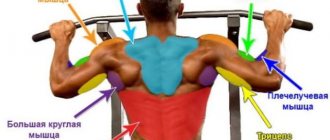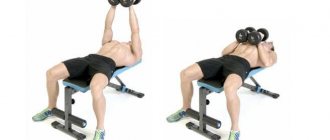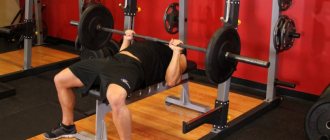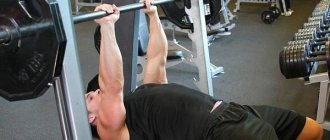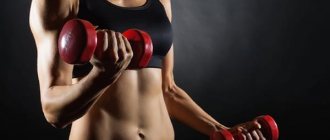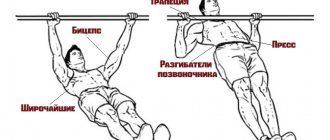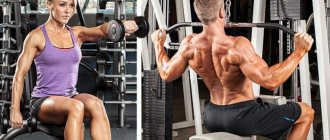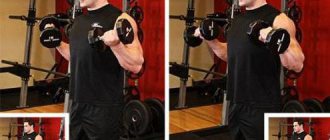Why are different grips used?
Different grips are used to pump muscles from different angles, more concentratedly affecting one or another area of the muscle group. By changing your grip, you change the groups of muscles being worked.
Thus, it turns out that there is no universal answer to the question: Which grip will be correct or which grip will be more effective. In most cases, the choice of grip will depend on the specific exercise and the goals you set for yourself when performing it.
Types of grips.
So, what types of grips are there? Depending on how your palm holds the bar or bar, there are three types of grip:
Straight or overhand grip.
Also called a pronated grip, from the word pronation, which means an inward rotational movement. In a position where the arms are lowered down, with this grip the palms will look back.
Neutral or parallel.
In a position where the arms are lowered down, with this grip both palms are facing the body and looking at each other. A neutral grip is also called a grip on the horizontal bar when the palms face in opposite directions.
Reverse or underhand grip.
The so-called supinated grip, from the word supination, which means an outward rotational movement. In a position where the arms are down, with this grip the palms will face forward.
When performing exercises, the distance of the hands from each other is of great importance, therefore, depending on the width of the hands, grips are also divided into three types.
Narrow grip.
With this grip, you should place your hands narrower than shoulder width. The amplitude of movement with a narrow grip is the maximum, which has a beneficial effect on the result. However, using a narrow grip, you often connect non-target muscles, such as triceps, which take part of the load on themselves and the effect of the exercise is reduced.
Medium grip.
With this grip, your hands are shoulder-width apart. The medium grip is the most common, considered classic and often serves to comprehensively work out the muscles involved in the exercise. Ideal for beginner athletes.
Wide grip.
A wide grip is a grip when your hands are positioned wider than your shoulders. With this grip, you can focus on the target muscle. However, this grip often reduces the effectiveness of the exercise, since it significantly reduces the range of motion.
According to the position of the thumb when gripping, grips differ into closed and open, or safe and dangerous, respectively.
Closed grip.
In this variant, four fingers hold the bar or crossbar on one side, and the thumb holds it on the other side, as if wrapping it in a ring. When performing exercises with a barbell, this type of grip is usually used, since it allows you to safely hold the apparatus. When performing exercises on the horizontal bar, it allows you to hold onto the bar more tenaciously.
Open grip (monkey, military).
This grip option is that the bar or crossbar is grasped not with four fingers, but with all five. In this case, the thumb does not hold, but simply touches the projectile. This grip is believed to help you press more weight. However, since the projectile can come off your hand, it should be used with great care. In exercises with dumbbells, such a grip is generally not recommended. When doing pull-ups on the horizontal bar, quite a lot of people use this grip; on this apparatus, this grip is also called a monkey grip or a military grip.
So let's take a look at what grips are used on different equipment.
Back
In everyday life, we use the muscles of the front part of the body more, so the back muscles are often underdeveloped, which leads to stooping. Your goal is to develop your entire body evenly. The exercises we offer with dumbbells will help you with this.
The bent over dumbbell row is a great core exercise for developing your core and upper back. When performing this exercise, a special stand is used, which makes it possible to completely turn off the lower back from work to avoid injury. The value of the exercise is that it can help correct back imbalances. To perform it, do the following: place your left knee on the bench. Then bend over and place your hand on it. The body is almost parallel to the floor. There is a deflection in the lower back. The right foot is on the floor. With your right hand, hold the dumbbell with a neutral grip. As you exhale, pull the dumbbell to your lower abdomen by contracting your back muscles. As you inhale, slowly lower the dumbbell to the starting position. Repeat the exercise on the other side.
This is an exercise to work your back muscles. The latissimus muscles receive the main load here. The main advantage of this exercise is that when it is performed, the load is removed from the lower back. Therefore, this exercise is suitable for people who cannot load their lower back. To perform it, take the weights and lie face down on an incline bench. Hold dumbbells with a neutral grip, with your arms straight at the sides of the bench. As you exhale, lift the dumbbells by bending your elbows. As you inhale, lower the dumbbells to the starting position.
Shrugs are an exercise that is aimed at training the trapezius muscle. Shrugs are performed with both dumbbells and a barbell. The advantage of dumbbells is that the movement of the exercise becomes more natural and the amplitude of the exercise increases. To perform it, take dumbbells in your hands and stand straight. Stretch your arms at your sides. As you exhale, pull your shoulders up as high as you can. Hold this position for a second and return to the starting position.
Grips when training with a barbell.
When performing exercises with a barbell, a closed grip is often used, which allows you to clearly fix the projectile in your hands. But there are still athletes who find it more convenient to hold the barbell with an open grip. This mainly applies to barbell exercises on the back and presses, especially the bench press, but since it is not safe, it will be better to use a closed grip.
The choice of a forward or reverse grip is often determined by the exercise itself, but different grip widths are often used when exercising with a barbell. All kinds of presses and rows are often recommended to be performed with different grip widths, which contributes to a more complete development of the target muscles.
Triceps
When you train triceps, like any other muscle group, you need to use a variety of equipment, including dumbbells, to vary the load as much as possible. Try to feel the triceps working and always pay attention to your technique. Don't forget that when you focus on how your muscles are working during a workout, you will recruit more muscle fibers. Therefore, each repetition and approach is more effective, and you get the desired results much faster.
The French press is a unique exercise for training the triceps. This exercise allows you to work the triceps along its entire length. When performing this exercise, the emphasis is on the load on the long head of the triceps. This exercise can be performed lying down or sitting. We suggest considering the option of performing the French bench press. Lie down on a bench and grab dumbbells with your palms facing each other. As you inhale, bend your arms and lower the dumbbells to your ears. As you exhale, extend your arms at the elbows, returning to the starting position.
Another exercise with dumbbells to pump up the triceps. This exercise cannot be called the best for training the triceps, but doing it will diversify your arm training, which will undoubtedly benefit you. It is performed as follows: take a dumbbell in your right hand and rest your left knee on the seat of the bench. Also rest your left hand on the back or seat of the bench. Bend your working arm at a right angle - this will be your starting position. Now straighten your arm at the elbow until it is completely straight, hold for a split second and return to the starting position. Perform the required number of times and repeat the exercise for the second hand.
Grips when training with dumbbells.
Dumbbells should always be held with a closed grip. Unlike the barbell, in exercises with dumbbells it is possible to change the grip directly during the exercise; this is often used. Holding the projectile at the starting point with one grip, we change it to another at the end point.
An example of changing between a straight, neutral or reverse grip would be an Arnold press or dumbbell lateral raises where we supinate or pronate the dumbbells as we press to the top. In exercises with dumbbells, the width of the grip is the distance between the hands, which is also customary to change in some exercises, bringing the hands together at the top point and spreading them out at the bottom, for example, when bench pressing dumbbells.
The ability to use these techniques gives dumbbells an advantage over the barbell, which allows for a more diverse impact on the muscles and, ultimately, a beneficial effect on their development.
Biceps
As with any strength exercise, proper technique and concentration are very important when training biceps with dumbbells. Also try to avoid common mistakes when doing exercises for the biceps muscles. For example, many people do not fix their shoulders and body in a stationary position, which takes some of the load off the biceps. Only the muscles supporting the elbow joint should work, while the shoulders, wrists and body remain motionless.
Dumbbell Curls
Dumbbell curls are one of the best exercises to train your biceps. The advantage of dumbbells over a barbell is the increased amplitude of wrist rotation, which provides better training of the biceps muscle. This exercise can be performed standing or sitting on a vertical or inclined bench. To perform it, take dumbbells and stand straight (or sit on a bench). The elbows are pressed to the sides of the body and remain motionless throughout the entire movement. As you exhale, bend your elbows. As you inhale, straighten your arms to return to the starting position.
Hammer grip dumbbell curls
The hammer is an isolation exercise aimed at developing the brachialis muscle, the muscle that is located under the biceps and which gives it the peak that all athletes desire. Perform the exercise standing or sitting on a bench. To do this, take dumbbells with a neutral grip and stand straight or sit on a bench. The arms are extended to the sides of the body. As you exhale, lift the dumbbells to shoulder level. As you inhale, lower the dumbbells back to the starting position.
The peculiarity of this exercise is the large range of motion and powerful peak contraction at the top point. The biceps receive the maximum load in this exercise. To perform the exercise correctly, sit on a bench and place your feet slightly wider than shoulder-width apart. Take a dumbbell, bend over slightly and rest your right elbow on the inside of your right leg. As you exhale, lift the dumbbell to your upper chest. As you inhale, return to the starting position. Perform the required number of times and repeat the exercise for the other hand.
Scott Bench Dumbbell Curls
The Scott Bench Dumbbell Curl is an exercise for targeted biceps training. The advantage of this exercise is that it eliminates the use of cheating, so the biceps brachii muscle receives maximum load. To perform it, sit on a Scott bench and hold dumbbells in both hands, palms facing up. You can also hold dumbbells with a hammer grip (palms facing each other) to work the brachialis muscle. As you exhale, straining your biceps, bend your arms as much as possible, raising the dumbbells to your shoulder. As you inhale, lower the dumbbells.
Grips for pull-ups on the horizontal bar.
This is where all sorts of different grips are used, namely when doing pull-ups on the horizontal bar. What you get as a result depends on exactly how you grab the crossbar. Different grips will help athletes with different levels of training achieve the desired result.
Using a reverse grip helps beginners master pull-ups, as it makes it easier to perform the exercise due to the fact that stronger biceps are involved in the work and removes some of the load from the back. The width of the grip helps the experienced athlete concentrate the load on individual areas of the back and work the target muscles.
As you can see, different grip styles are an important part of the training process, so it is advisable to take the time to learn how to use them in different situations. Knowing the intricacies and characteristics of different types of grip and applying them in practice will help diversify and improve your training, which in turn will help you achieve the result you want.
Features of the exercise
With dumbbells with a neutral grip or hammers you train:
- biceps;
- brachialis (brachial muscle);
- brachioradialis (brachioradialis muscle);
- pronator teres.
Distribution of the load across the muscles during the exercise.
One exercise helps develop a number of small muscles. Some trainers classify the hammer as a basic exercise, but this is not entirely true. The muscle groups being developed are too small. Moreover, the movement is carried out due to the work of one joint. For these reasons, it is more correct to consider it isolated.
The main advantage of this type of curl is that it allows you to increase the overall muscle mass of your arms. Muscle development occurs in a complex manner, and you will definitely be pleased with the end result.
The grip you use directly affects which muscles receive the most stress. Before you start training, pay attention to the following nuances:
- The more the palm looks down, the greater the load on the brachialis.
- The more the palm is turned upward, the greater the load on the biceps.
- A neutral grip, with your palms facing each other, targets both of these muscles evenly.
When choosing which grip to hold the dumbbells in, think about which muscles you want to develop first.
